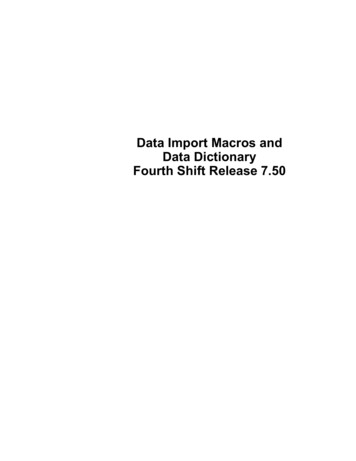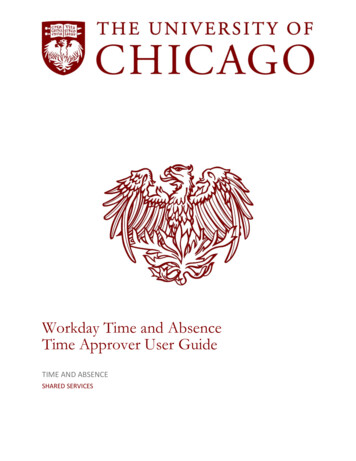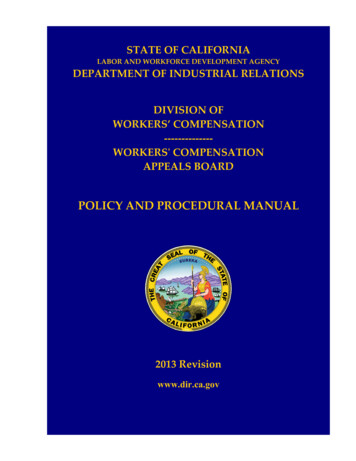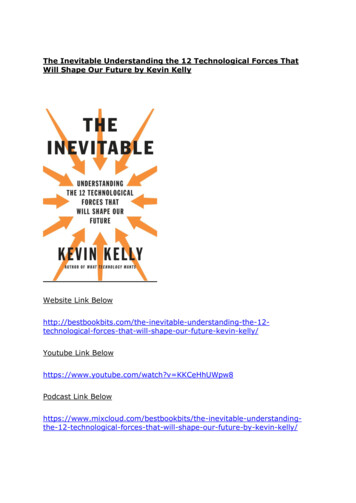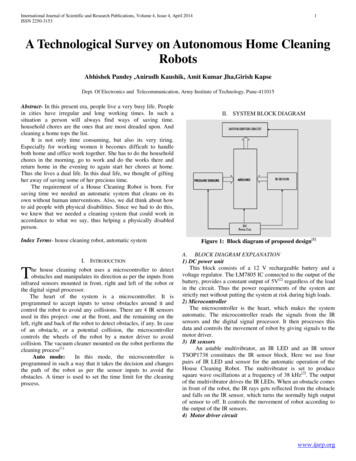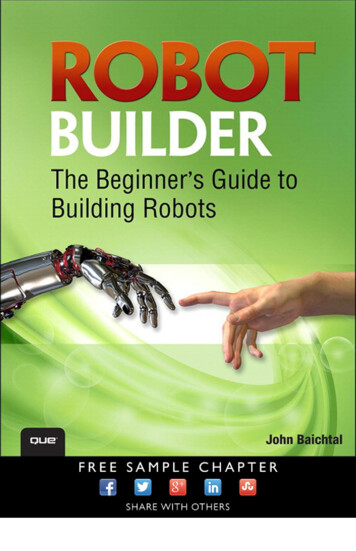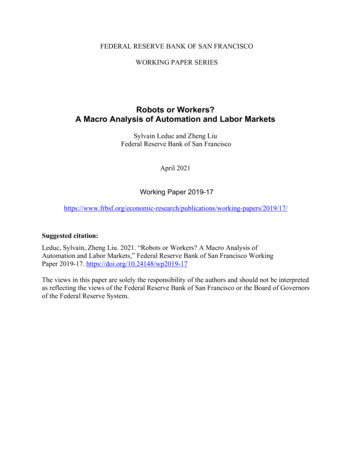
Transcription
FEDERAL RESERVE BANK OF SAN FRANCISCOWORKING PAPER SERIESRobots or Workers?A Macro Analysis of Automation and Labor MarketsSylvain Leduc and Zheng LiuFederal Reserve Bank of San FranciscoApril 2021Working Paper lications/working-papers/2019/17/Suggested citation:Leduc, Sylvain, Zheng Liu. 2021. “Robots or Workers? A Macro Analysis ofAutomation and Labor Markets,” Federal Reserve Bank of San Francisco WorkingPaper 2019-17. https://doi.org/10.24148/wp2019-17The views in this paper are solely the responsibility of the authors and should not be interpretedas reflecting the views of the Federal Reserve Bank of San Francisco or the Board of Governorsof the Federal Reserve System.
ROBOTS OR WORKERS? A MACRO ANALYSIS OF AUTOMATIONAND LABOR MARKETSSYLVAIN LEDUC AND ZHENG LIUAbstract. We argue that the threat of automation weakens workers’ bargaining power inwage negotiations, dampening wage adjustments and amplifying unemployment fluctuations.We make this argument based on a quantitative business cycle model with labor marketsearch frictions, generalized to incorporate automation decisions and estimated to fit U.S.time series. In the model, procyclical automation probability creates real wage rigiditiesthat help amplify labor market fluctuations. We find that this automation mechanism isquantitatively important for explaining the large volatilities of unemployment and vacanciesrelative to that of real wages, a puzzling observation through the lens of standard businesscycle models.I. IntroductionRecent advances in robotics and artificial intelligence have raised concerns that automation is putting an increasing share of jobs at risk and reducing wages. There is an on-goingdebate about whether automation reduces aggregate employment (Autor, 2015; Acemogluand Restrepo, 2018, 2020). However, to the extent that automation is a labor-saving technology, the threat of automation might weaken workers’ bargaining power and thus restrainwage increases, even if robots are not actually adopted. The option to automate may becomeparticularly attractive when firms face a tight labor market, in which hiring workers is difficult without substantial wage increases. In this paper, we argue that, by lowering workers’effective bargaining power, the increased threat of automation in expansions acts as a formof endogenous wage rigidity and helps explain the large fluctuations in unemployment andDate: April 12, 2021.Key words and phrases. Robots, automation, unemployment, wages, productivity, Shimer puzzle, business cycles.JEL classification: E24, J64, O33.Leduc: Federal Reserve Bank of San Francisco. Email: Sylvain.Leduc@sf.frb.org. Liu: Federal ReserveBank of San Francisco. Email: Zheng.Liu@sf.frb.org. For helpful comments, we thank Martin Eichenbaum,John Fernald, Chad Jones, Mike Keane, Emi Nakamura, Brent Neiman, Nicolas Petrosky-Nadeau, JonSteinsson, Robert Townsend, and participants at the West Coast Search and Matching Workshop, HKUSTMacro workshop, Hong Kong University, INSEAD, National University of Singapore, University of AutonomaBarcelona, University of New South Wales, and the 2020 Econometric Society World Congress. We aregrateful to Lily Seitelman and Remy Beauregard for excellent research assistance and to Anita Todd foreditorial assistance. The views expressed herein are those of the authors and do not necessarily reflect theviews of the Federal Reserve Bank of San Francisco or of the Federal Reserve System.1
ROBOTS OR WORKERS2vacancies relative to real wages, a puzzling observation through the lens of standard businesscycle models (Shimer, 2005).We formalize this argument based on a general equilibrium framework with labor marketsearch frictions, generalized to incorporate automation decisions and estimated to fit U.S.time series. This theoretical framework allows us to study the interactions between firms’employment and automation decisions over the business cycle.1 A framework with searchfrictions in the labor market is also natural, since we are interested in the joint dynamics ofunemployment, job vacancies, and wages.The model predicts that an increased threat of automation raises firms’ reservation valuein wage negotiations, strengthening their bargaining power and therefore dampening wageincreases during economic expansions. In our model, the effective bargaining power betweenfirms and workers is endogenous, and it fluctuates with the endogenous probability of automation over the business cycle. The automation channel creates two opposing forces onreal wages. In an expansion, a tighter labor market pushes real wages up. At the sametime, the net benefit of automation and thus the probability of automation also rise, andthe increased threat of automation slows wage growth.The automation channel also creates two opposing effects on employment. It has a directjob-displacing effect, because robots can substitute for workers in production. On the otherhand, automation has a job creating effect, because the option to automate an unfilled jobposition raises the expected value of a job vacancy, boosting firms’ incentive to create newvacancies and thus increasing the job finding rate and employment.Our estimation suggests that the automation mechanism is a quantitatively importantsource of real wage rigidities, and it helps account for the observed large volatilities ofunemployment and vacancies. In addition, since automation raises labor productivity whiledepressing wages, it leads to countercyclical fluctuations in the labor share of income, asobserved in the data.I.1. Model mechanism. We generalize the standard Diamond-Mortensen-Pissarides (DMP)model with labor market search frictions to build a tractable framework that incorporatesautomation decisions.Our theoretical framework features two important departures from the standard DMPmodel. First, we introduce a fixed cost of vacancy creation (Fujita and Ramey, 2007; Leduc1Our general equilibrium approach is complementary to a large body of empirical literature that focuseson the causal impact of automation on different outcome variables (e.g., employment and wage growth)using instrumental variables to control for the possibility of reverse causation (Autor and Salomons, 2018;Acemoglu and Restrepo, 2020; Acemoglu et al., 2020). For instance, low employment growth resulting fromhiring difficulties in expansions may lead to more automation.
ROBOTS OR WORKERS3and Liu, 2020). A firm will choose to create a new vacancy if and only if the net presentvalue of the vacancy is non-negative. Thus, in an equilibrium, an unfilled vacancy has apositive present value. Second, we introduce endogenous automation decisions. A vacancyin our model can be interpreted as a continuum bundle of tasks, which are ex ante identical,but a fraction of which can be automated depending on costs of automation. Only nonautomated tasks (vacancies) are posted for hiring workers. Thus, in equilibrium, some tasksare performed by robots (i.e., automated tasks) and some other tasks by workers (providedthat a match is formed in the labor market). Since robots can substitute for workers inproduction, they are different from the physical capital in standard neoclassical productionfunctions, where capital and labor are complementary inputs.2In line with Acemoglu and Restrepo (2018) and Zeira (1998), firms in our model first makea choice of technologies (adopting a robot or not); and then post those non-automated tasks(i.e., vacancies) for hiring workers.3To implement this approach, we assume that each firm observes an i.i.d. cost of automationin the beginning of each period and decides whether or not to automate an unfilled jobvacancy carried over from the previous period. At this stage of the decisions, the taskscan be indexed by the realized automation costs. A task will be automated if and only ifthe cost of automation lies below a threshold determined by the net benefit of automation;in which case, the firm adopts a robot for production and takes the job vacancy offline.The probability of automation is thus the cumulative density of the automation cost drawsevaluated at the automation threshold.After the automation decisions, the firm pools the non-automated tasks (which are againidentical because the automation costs are irrelevant at the stage for hiring decisions) andposts those vacancies in the labor market to search for a potential match with job seekers. Ifa match is successful, a vacancy will be filled with a worker and both the firm and the workerobtain their respective share of the employment surplus from bargaining over the wage rate.If no match is formed, then the vacancy remains open and the firm obtains the continuationvalue of the vacancy, including the option to automate it in future periods.2Krusell et al. (2000) study a neoclassical model in which capital equipment complements skilled laborbut substitutes for unskilled labor. He and Liu (2008) study a general equilibrium extension of the Krusellet al. (2000) model to incorporate endogenous skill accumulations. The relation between robots and workersin our model is analogous to the relation between equipment and unskilled labor in the model of Krusellet al. (2000).3We focus on firms’ ability to use automation as a potential margin of adjustments in response to changesin labor market conditions over the business cycles. In an expansion, for example, firms face a tighterlabor market, in which job vacancies are harder to fill. This creates an incentive for adopting labor-savingtechnologies such as automation.
ROBOTS OR WORKERS4Our approach to modeling automation requires job vacancies to carry a positive value,which is an equilibrium outcome in our model since vacancy creation is costly. The optionto automate an unfilled vacancy raises the vacancy value, providing an extra incentive forfirms to create new vacancies. But an increase in the value of a vacancy would also boostthe firm’s reservation value in wage negotiations, effectively weakening workers’ bargainingpower, depressing wage increases. Thus, the threat of automation (i.e., the endogenousprobability of robot adoptions) creates a source of real wage rigidity that contains wagechanges and amplify the fluctuations of unemployment and vacancies over the business cycle.I.2. Model implications. We estimate the model to fit quarterly U.S. time series data.These time series include unemployment, vacancies, real wage growth, and nonfarm businesssector labor productivity growth, with a sample ranging from 1985:Q1 to 2018:Q4. To fitthese four time series, we assume four shocks in our model, including a discount factor shock,a neutral technology shock, an automation-specific shock, and a job separation shock. Wefind that matching the observed fluctuations in labor productivity is an important disciplining device on the endogenous automation mechanism, especially because of the slowdown inproductivity growth since the mid-2000s (Fernald, 2015).We find that the threat of automation dampens wage increases in a business cycle boom.Since the net value of automation is procyclical, the probability of automation increasesin expansions. The model’s implied procyclical automation investment is consistent withmacroeconomic evidence. For example, Figure 1 shows that, in the U.S. data, aggregate realprivate investment in computers and peripheral equipment and in information processingequipment—both categories closely related to automation equipment—rise in expansions andfall in recessions, as does aggregate equipment investment. All three categories of equipmentinvestment are positively correlated with real GDP growth in the sample period from 1985:Q1to 2019:Q4, with correlation coefficients of 0.46, 0.58, and 0.71, respectively. Furthermore,the shipment of industrial robots is also procyclical, as reported by Kopytov et al. (2018)based on data from the International Federal of Robotics (IFR).An increase in automation probability in a business cycle boom raises the firm’s reservationvalue (i.e., the value of a vacancy) and effectively weakens the worker’s bargaining power inwage negotiations, and therefore muting wage increases. By dampening wage changes, theautomation channel amplifies the fluctuations in unemployment and vacancies. Increasedautomation in a boom also boosts aggregate productivity, further fueling the expansion.Since automation improves labor productivity while muting wage increases, it implies acountercyclical labor income share, as observed in the data.44Karabarbounis and Neiman (2013) focus on the trend declines in the labor share since the mid-1970sfor 59 countries. Their analysis attributes about half of the declines in the labor share to declines in the
ROBOTS OR WORKERS5Figure 1. Year-over-year percentage changes in real private investment incomputers and peripherals (blue line), information processing equipment(green line), and aggregate equipment (yellow line). The gray shaded barsindicate recessions based on the NBER recession dates. The sample periodcovers 1985:Q1-2019:Q4. Source: U.S. Bureau of Economic Analysis and HaverAnalytics.Overall, automation helps generate large fluctuations in unemployment and vacanciesrelative to that in real wages. The threat of automation gives rise to a source of endogenousreal wage rigidities, which is important for amplifying labor market fluctuations (Christianoet al., 2020). In addition, automation raises aggregate productivity in a business cycle boom,relative price of investment goods. Elsby et al. (2013) also study the trend declines in the U.S. labor sharesince the 1980s. They argue that offshoring of labor-intensive component of the U.S. supply chain is animportant factor that may explain the declines in the labor share. We focus on the cyclical dynamics of thelabor share, instead of its trend.
ROBOTS OR WORKERS6further fueling the boom. This mechanism is quantitatively important. In our estimatedmodel and the data, the volatility of the vacancy-unemployment ratio (i.e., the v-u ratio),which is a measure of labor market tightness, is about 37 times that of the real wage rate.5In contrast, a counterfactual model without the automation mechanism produces a muchsmaller volatility ratio of about 9, less than 25 percent of that predicted by our estimatedmodel. Furthermore, we show that search frictions are also important: a more competitivelabor market tends to mitigate the real wage rigidity stemming form the threat of automation,making unemployment and vacancies less volatile. In this sense, automation and labormarket search frictions are both important for understanding the observed labor marketfluctuations.The threat of automation effectively weakens workers’ bargaining power and thereforemutes wage changes and amplifies unemployment fluctuations. Hagedorn and Manovskii(2008) argue that, in the standard DMP framework, reducing workers’ bargaining weightor raising the workers’ value of non-market activity (such as unemployment insurance) canamplify fluctuations in unemployment and vacancies. Thus, we consider two such counterfactuals, both without the automation mechanism. We find that lowering workers’ bargainingweight or raising the unemployment insurance (UI) can dampen wage adjustments and amplify unemployment fluctuations, in line with the findings in Hagedorn and Manovskii (2008).However, the magnitude of amplification is substantially smaller than that arising from thethreat of automation. In addition, the impulse responses of wages and the labor share in thecounterfactual models are qualitatively different from those in our benchmark model. Forexample, following a positive discount factor shock, the benchmark model predicts that thereal wage and the labor share both decline, whereas the counterfactuals without automation predict that they both rise. These differences reflect the importance of the automationthreat for wage bargaining and the endogenous productivity changes through the automationchannel.The automation mechanism is also robust to introducing heterogeneous worker skills. Ina generalized version of the model, we assume that robots are substitutes for low-skilledworkers but complements to high-skilled workers. In this case, we continue to find that thethreat of automation depresses wages and boosts productivity, leading to countercyclicallabor share fluctuations. We also find that the volatility of the vacancy-unemployment ratiorelative to that of real wages remains high in this environment, though somewhat lower thanthat obtained in our benchmark model. This attenuation effect reflects the business-cyclemovements in skilled wages and the resulting changes in the cost of using robots. Sincerobots and skilled workers are complementary, an increase in skilled wages in a business5Since we fit our model to these time series, the actual volatility ratio in the data is the same.
ROBOTS OR WORKERS7cycle expansion would raise the cost of using the automation technology, mitigating theincentive for firms to automate and resulting in greater fluctuations in unskilled wages.Our framework can be generalized to study the implications of offshoring for labor marketfluctuations. Elsby et al. (2013) highlight the importance offshoring in accounting for theobserved declines in the U.S. labor income share. To the extent that offshoring is a formof labor-saving technology, we conjecture that the threat of offshoring can exert similarinfluences on labor market outcomes as does the threat of automation.I.3. Related literature. Our estimated general equilibrium model highlights the interactions between automation and labor market fluctuations at the business cycle frequencies.Our findings complements the empirical literature that typically focuses on longer-run implications of automation. For example, Graetz and Michaels (2018) examine the labor-marketimpact of cumulative changes in robot adoptions from 1993 to 2007 using a panel of industrylevel data from 17 countries. They find that robot adoptions boost labor productivity andraise wages, although the positive effects on wages are much smaller than those on productivity. Arnoud (2018) also focuses on the long-run implications of automation. He examinesoccupation-level relations between the threat of automation and wage adjustments usingdata from the 2013 U.S. Current Population Survey and an index of automatability for different occupations developed by Frey and Osborne (2017). He finds that, controlling forobservable characteristics, occupations that are more susceptible to automation have experienced lower wage growth. Dinlersoz and Wolf (2018) present plant-level evidence that moreautomated establishments in the U.S. manufacturing sector have had a smaller fraction ofhigh-wage workers, higher labor productivity, and a smaller labor share in production. Acemoglu and Restrepo (2020) present evidence that, for U.S. communter zones exposed torobots, the increase in the stock of industrial robots between 1990 and 2007 reduced theaverage employment-to-population ratio by 0.4 percentage points and average wages by 0.8percent, relative to commuter zones with no robot exposure.Automation in our model represents a labor-substituting technology, in line with Acemogluand Restrepo (2018). There is substantial evidence that the steady progress in labor substituting technologies (such as computerization) has reduced the secular demand for workerswith routine skills, contributing to job polarization in the U.S. labor market (Autor et al.,2003; Autor, 2015). Furthermore, job polarization can be linked to the jobless recoveriessince the early 1990s, because most of the employment losses in routine occupations occurin recessions (Jaimovich and Siu, 2020). During the Great Recession and the subsequentrecovery, employers in hard-hit areas raised the skill requirements when posting job vacancies, consistent with increased job destructions in routine occupations (Hershbein and Kahn,2018). Although our benchmark model abstracts from skill heterogeneity, our extended
ROBOTS OR WORKERS8model with heterogeneous worker skills captures the idea that robots are complementarywith high-skill workers but are substitutes for low-skill workers. The key predictions of ourbenchmark model survives in this extended model. In particular, increases in automationraises labor productivity, reduces wages and the labor share.Different from the existing literature that focuses on the secular impact of automation onlabor markets, we focus on business cycle fluctuations. To our knowledge, our study providesthe first quantitative general equilibrium evaluation of the interactions between automationand labor market fluctuations over the business cycle.II. The model with labor market frictions and automationThis section presents a DSGE model that generalizes the standard DMP model to incorporate endogenous decisions of automation.To keep automation decisions tractable, we impose some assumptions on the timing ofevents. In the beginning of period t, a job separation shock δt is realized. Workers who losetheir jobs add to the stock of unemployment from the previous period, forming the pool ofjob seekers ut . Firms carry over the stock of unfilled vacancies from the previous period, afraction of which is automated by adopting robots. The stock of vacancies vt available forhiring workers consists of the remaining vacancies after automation, the jobs separated inthe beginning of the period, and newly created vacancies. The job seekers (ut ) randomlymatch with the vacancies (vt ) in the labor market, with the number of new matches (mt )determined by a matching technology. Production then takes place, with a homogeneousconsumption good produced using either workers or robots. The unfilled vacancies and thepool of employed workers at the end of the period are carried over to the next period, andthe same sequence of economic activities repeats in period t 1.Compared to the standard DMP model, our model introduces two new features. First,we replace the free-entry assumption in the DMP model with costly vacancy creation, asin Fujita and Ramey (2007) and Leduc and Liu (2020). Since creating a new vacancyincurs a fixed cost, a vacancy has a positive value even if it is not filled by a worker. Thenumber of vacancies becomes a slow-moving state variable (instead of a jump variable asin the standard DMP framework), enabling our model to match the persistent vacancydynamics in the data. Second, we introduce endogenous automation decisions. We focuson firms’ ability to use automation as a labor-saving device when labor markets tighten inexpansions. In the beginning of period t, each firm draws a fixed automation cost, whichdetermines whether the firm will adopt a robot or post the vacancy for hiring a worker. If theautomation cost lies below a threshold value, then the firm adopts a robot and obtains theautomation value, and the vacancy would be taken offline. If the automation cost exceeds the
ROBOTS OR WORKERS9threshold, then the firm posts the vacancy for hiring a worker.Since robots can substitutefor workers for production, they are different from the traditional capital input, which istypically complementary to labor input in the standard macro models.II.1. The Labor Market. In the beginning of period t, there are Nt 1 existing job matches.A job separation shock displaces a fraction δt of those matches, so that the measure ofunemployed job seekers is given byut 1 (1 δt )Nt 1 ,(1)where we have assumed full labor force participation and normalized the size of the laborforce to one.The job separation rate shock δt follows the stationary stochastic processln δt (1 ρδ ) ln δ̄ ρδ ln δt 1 εδt ,(2)where ρδ is the persistence parameter and the term εδt is an i.i.d. normal process with amean of zero and a standard deviation of σδ . The term δ̄ denotes the steady-state rate ofjob separation.The stock of vacancies vt consists of unfilled vacancies carried over from period t 1 thatare not automated, plus the separated employment matches and newly created vacancies.The law of motion for vacancies is given byvvt (1 qt 1)(1 qta ))vt 1 δt Nt 1 ηt ,(3)vwhere qt 1denotes the job filling rate in period t 1, qta denotes the automation probabilityin period t, and ηt denotes newly created vacancies (i.e., entry).In the labor market, new job matches (denoted by mt ) are formed between job seekersand open vacancies based on the matching functionmt µuαt vt1 α ,(4)where µ is a scale parameter that measures matching efficiency and α (0, 1) is the elasticityof job matches with respect to the number of job seekers.The flow of new job matches adds to the employment pool, whereas job separations subtract from it. Aggregate employment evolves according to the law of motionNt (1 δt )Nt 1 mt .(5)At the end of period t, the searching workers who failed to find a job match remainunemployed. Thus, unemployment is given byUt ut mt 1 Nt .(6)
ROBOTS OR WORKERS10For convenience, we define the job finding probability qtu asqtu mt.ut(7)Similarly, we define the job filling probability qtv asqtv mt.vt(8)II.2. The firms. A firm makes automation decisions in the beginning of the period t. Adopting a robot requires a fixed cost x in units of consumption goods. The fixed cost is drawnfrom the i.i.d. distribution G(x). A firm chooses to adopt a robot if and only if the costof automation is less than the benefit. For any given benefit of automation, there exists athreshold value x t in the support of the distribution G(x), such that automation occurs ifand only if x x t . If the firm adopts a robot to replace the job position, then the vacancywill be taken offline and not available for hiring a worker. Thus, the automation thresholdx t depends on the value of automation (denoted by Jta ) relative to the value of a vacancy(denoted by Jtv ). In particular, the threshold for automation decision is given byx t Jta Jtv .(9)The probability of automation is then given by the cumulative density of the automationcosts evaluated at x t . That is,qta G(x t ).(10)The flow of automated job positions adds to the stock of automated positions (denotedby At ), which becomes obsolete at the rate ρo [0, 1] in each period.6 Thus, At evolvesaccording to the law of motionvAt (1 ρo )At 1 qta (1 qt 1)vt 1 ,(11)vwhere qta (1 qt 1)vt 1 is the number of newly automated job positions.A robot produces Zt ζt units of output, where Zt denotes a neutral technology shock and ζtdenotes an automation-specific shock. The neutral technology shock Zt follows the stochasticprocessln Zt (1 ρz ) ln Z̄ ρz ln Zt 1 εzt .(12)The parameter ρz ( 1, 1) measures the persistence of the technology shock. The termεzt is an i.i.d. normal process with a zero mean and a finite variance of σz2 . The term Z̄ isthe steady-state level of the technology shock.7 The automation-specific technology shock6Ifa vacancy is “filled” by a robot, it will be taken offline once and for all. Even if the robot laterbecomes obsolete, the vacated position does not return to the stock of vacancies.7The model can easily be extended to allow for trend growth.
ROBOTS OR WORKERS11ζt follows a stochastic process that is independent of the neutral technology shock Zt . Inparticular, ζt follows the stationary processln ζt (1 ρζ ) ln ζ̄ ρζ ln ζt 1 εζt .(13)The parameter ρζ ( 1, 1) measures the persistence of the automation-specific technologyshock. The term εζt is an i.i.d. normal process with a zero mean and a finite variance of σζ2 .The term ζ̄ is the steady-state level of the automation-specific technology shock.To simplify the analysis and concentrate on the main mechanism, we assume that operatingthe robot incurs a flow fixed cost κa that captures the costs of facilities and the space forautomated production.8 The value of automation satisfies the Bellman equationaJta Zt ζt κa (1 ρo )Et Dt,t 1 Jt 1,(14)where Dt,t 1 denotes the stochastic discount factor determined by the marginal utility of thehouseholds.If the automation cost exceeds the threshold x t , then the firm chooses not to adopt arobot and instead, it chooses to post the vacancy in the labor market for hiring a worker.In addition, newly separated jobs and newly created vacancies add to the stock of vacanciesfor hiring workers. Following Leduc and Liu (2020), we assume that creating a new vacancyincurs an entry cost e in units of consumption goods. The entry cost is drawn from ani.i.d. distribution F (e). A new vacancy is created if and only if the net value of entry isnon-negative. The benefit of creating a new vacancy is the vacancy value Jtv . Thus, thenumber of new vacancies ηt is given by the cumulative density of the entry costs evaluatedat Jtv . That is,ηt F (Jtv ).(15)Posting a vacancy incurs a per-period fixed cost κ (in units of final consumption goods).If the vacancy is filled (with the probability qtv ), the firm obtains the employment valueJte . Otherwise, the firm carries over the unfilled vacancy to the next period, which will beaautomated with the probability qt 1. If the vacancy is automated, then the firm obtains theaautomation value Jt 1net of the expected robot adoption costs; otherwise, the vacancy willvremain open, and the firm receives the vacancy value Jt 1. Thus, the vacancy value satisfiesthe Bellman equationJtv κ qtv Jte (1 qtv )Et Dt,t 1 Zaaqt 1 Jt 1 x t xdG(x) (1 avqt 1)Jt 1 .(16)08Thissimplification, however, does not drive our main results, as we show in Section V.2, where wegeneralize the benchmark framework to allow for worker skill heterogeneity. In that generalized framework,operating a robot requires skilled workers. Thus the flow cost of using the automation technology becomesendogenous, and in particular, it depends on the wage rate of skilled workers.
ROBOTS OR WORKERS12If a firm succes
Recent advances in robotics and arti cial intelligence have raised concerns that automa-tion is putting an increasing share of jobs at risk and reducing wages. There is an on-going debate about whether automation reduces aggregate employment (Autor, 2015; Acemoglu and Restrepo, 2018, 2020). However, to t
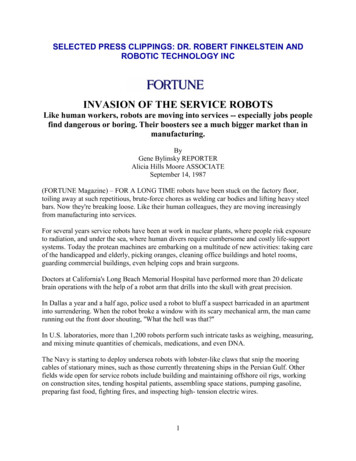
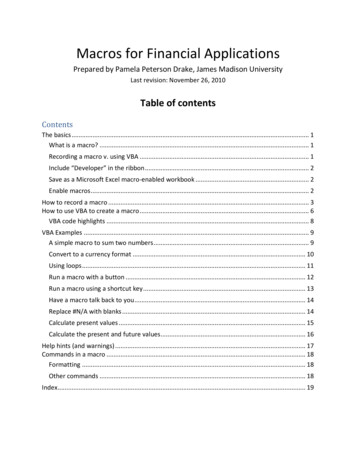
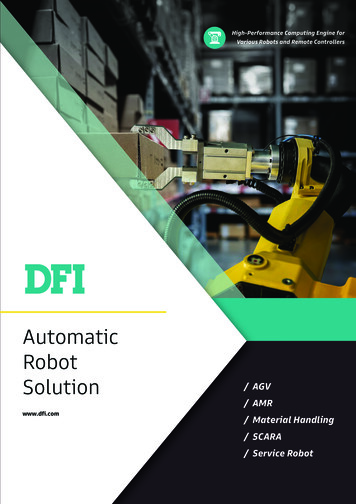
![[MS-OFFMACRO]: Office Macro-Enabled File Format](/img/3/5bms-offmacro-5d-130211.jpg)
